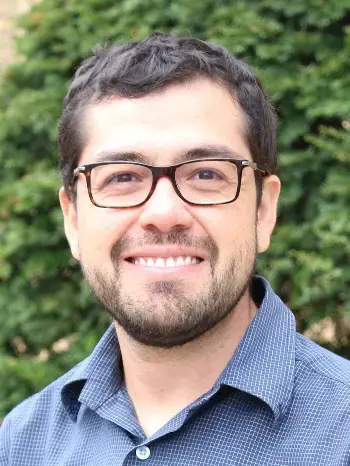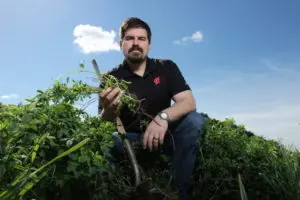On paper, Wisconsin dairy farms look like the model of sustainable agriculture. Cows are fed hay and silage and graze in pastures. They produce manure which is collected and spread on agricultural fields as fertilizer. Then, voila! That manure boosts the yields of hay and corn, completing the circle.
 Victor Zavala
Victor Zavala
The problem is that Wisconsin’s 1.2 million cows produce a lot of manure—about 26.5 million tons a year. And, no matter how well a system is managed, some manure components make their way into the environment. As you increase the amount of manure applied as fertilizer, the risk for losses increases, causing concerns for humans and ecosystems.
Because producers have increased the density of cows on farms to improve economics and because manure is not a particularly well-balance fertilizer for many crops, manure or manure components are often applied in excess to fields. This can result in residual nutrients in the soil that increase losses to the environment.
Take for example phosphorus. Phosphorus contained in manure is applied to fields to promote crop growth. Over time, excess phosphorous that crops do not uptake—about 35,000 tons per year—builds up in the soil and is then more easily washed into lakes, rivers and streams. In those waterways, cyanobacteria, also known as blue-green algae, use the excess phosphorous to multiply rapidly, leading to algae blooms that suck up all the available oxygen in the water. Some cyanobacteria also release toxins into the water as they die and decompose.
 Brian Pfleger
Brian Pfleger
The results are dead fish, bad odors, closed beaches, angry waterfront property owners and economic hardship for tourism businesses that rely on clean lakes. As climate change progresses and temperatures rise, the proliferation of algae blooms will likely increase; in fact, in 2021, chilly Lake Superior, once believed to be immune from the phenomenon, saw its first algae blooms ever.
Processing manure can alter the manure in ways that can reduce issues associated with spreading it directly on fields. Researchers at the University of Wisconsin-Madison are designing a new on-farm system that will allow producers to convert manure into a well-balanced biofertilizer by treating it with engineered cyanobacteria. The team recently received a $2.0 million Emerging Frontiers in Research and Innovation grant from the National Science Foundation to develop and test this innovative approach.
 Andrew Greenberg
Andrew Greenberg
“The fundamental observation is that these cyanobacteria are actually capable of taking up this phosphorus to grow—so, they are natural phosphorus-capture agents,” says Victor Zavala, a professor of chemical and biological engineering at UW-Madison and principal investigator on the project. “We propose growing algae on the farms as opposed to letting it grow wild in the lakes. The idea is to build bioreactors that use the manure as a medium for algae growth. Then you’ll collect the algae and sell it as a biofertilizer.”
The goal of the project is to develop strains of cyanobacteria that will adjust the ratio of phosphorous and nitrogen in the manure as they gobble it up. After the cyanobacteria die, their biomass can be dried and pelletized to produce a balanced biofertilizer, which farmers could use or sell. Over time, by using the right balance of fertilizers, farmers could reduce the excess phosphorous applications on their fields and reduce use of synthetic fertilizers, which are produced from natural gas and use a huge amount of energy to create.
 Rebecca Larson
Rebecca Larson
The project is just getting underway, and the researchers still need to learn more about the systems that might work best. For instance, would it be more economical to have a small bioreactor on each farm or is it better to have larger, more centralized reactors operated as cooperatives?
If the technology reaches the commercialization stage, there’s also the issue of adoption. “Farmers are still very skeptical about using biofertilizers. They would rather use manure than trust something unknown,” says Zavala. So, researchers are also investigating how best to use the algae-based fertilizers to ensure optimal crop yields.
 Matt Ruark
Matt Ruark
While the bioreactors will help prevent phosphorous from making it into waterways, there is another exciting side project brewing: by setting up algae “farms” in lakes with these special algae, operators could continuously harvest the algae biomass and potentially sell it to chemical companies, which could use it to produce biodiesel.
The problem of nutrient pollution isn’t just an issue for fish. Zavala says his team is collaborating with the U.S. Environmental Protection Agency, which believes the problem is a matter of environmental justice, especially for rural communities. “One of the problems in Wisconsin in particular is that little bodies of water tend to get polluted faster, because the volume of water is less,” Zavala says. “Those little lakes are important because you have communities that depend on them. If they’re polluted, you have a problem. That’s something the EPA is concerned about.”
The research team also includes co-PI Brian Pfleger, a professor of chemical and biological engineering and a synthetic biology researcher; Distinguished Faculty Associate Andrew Greenberg, who will coordinate public outreach and education; and from the College of Agricultural and Life Sciences, Rebecca Larson, an associate professor of biological systems engineering, and Matt Ruark, a professor of soil science.
Victor Zavala is Baldovin-DaPra Professor of Chemical and Biological Engineering. Brian Pfleger is the Jay and Cynthia Ihlenfeld Professor of Chemical and Biological Engineering.